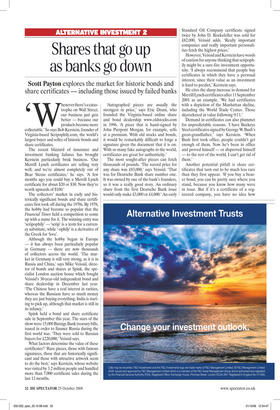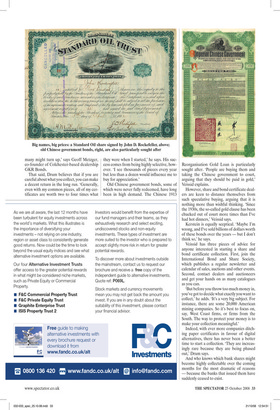Shares that go up as banks go down
Scott Payton explores the market for historic bonds and share certificates — including those issued by failed banks ‘Whenever there’s a catastrophe on Wall Street, our business just gets better — because our products become more collectable.’ So says Bob Kerstein, founder of Virginia-based Scripophily.com, the world’s largest buyer and seller of historic bonds and share certificates.
The recent blizzard of insurance and investment banking failures has brought Kerstein particularly brisk business. ‘Our Merrill Lynch certificates are selling very well, and we’re almost completely out of Bear Sterns certificates,’ he says. ‘A few months ago you could buy a Merrill Lynch certificate for about $20 or $30. Now they’re worth upwards of $100.’ The collectors’ market in early and historically significant bonds and share certificates first took off during the 1970s. By 1978, the hobby had become so popular that the Financial Times held a competition to come up with a name for it. The winning entry was ‘scripophily’ — ‘scrip’ is a term for a currency substitute, while ‘-ophily’ is a derivative of the Greek for ‘love’.
Although the hobby began in Europe — it has always been particularly popular in Germany — there are now thousands of collectors across the world. ‘The market in Germany is still very strong, as it is in Russia and China,’ says Mike Veissid, director of bonds and shares at Spink, the specialist London auction house which bought Veissid’s 30-year-old independent bond and share dealership in December last year. ‘The Chinese have a real interest in rarities, whereas the Russians have so much money they are just buying everything. India is starting to pick up, although that market is still in its infancy.’ Spink held a bond and share certificate sale in September this year. The stars of the show were 15,000 Barings Bank treasury bills, issued in order to finance Russia during the first world war. ‘They were sold to Russian buyers for £220,000,’ Veissid says.
What factors determine the value of these certificates? ‘Rare pieces, those with famous signatures, those that are historically significant and those with attractive artwork seem to do the best,’ says Kerstein, whose website was visited by 3.2 million people and handled more than 7,000 certificate sales during the last 12 months. ‘Autographed pieces are usually the strongest in price,’ says Eric Drum, who founded the Virginia-based online share and bond dealership www.oldstocks.com in 1996. ‘A piece that is hand-signed by John Pierpont Morgan, for example, sells at a premium. With old stocks and bonds, it would be remarkably difficult to forge a signature given the document that it is on. With so many fake autographs in the world, certificates are great for authenticity.’ The most sought-after pieces can fetch thousands of pounds. ‘The record price for any share was £83,000,’ says Veissid. ‘That was for Deutsche Bank share number one. It was owned by one of the bank’s founders, so it was a really good story. An ordinary share from the first Deutsche Bank issue
SP_FandC P069L 125x269 2510:SPFandC
would only make £3,000 or £4,000.’ An early Standard Oil Company certificate signed twice by John D. Rockefeller was sold for £82,000, Veissid adds. ‘Really important companies and really important personalities fetch the highest prices.’ However, Veissid and Kerstein have words of caution for anyone thinking that scripophily might be a sure-fire investment opportunity. ‘I always recommend that people buy certificates in which they have a personal interest, since their value as an investment is hard to predict,’ Kerstein says.
He cites the sharp increase in demand for Merrill Lynch certificates after 11 September 2001 as an example. ‘We had certificates with a depiction of the Manhattan skyline, including the World Trade Center. Those skyrocketed in value following 9/11.’ Demand in certificates can also plummet for unpredictable reasons. ‘I have Buckeye Steel certificates signed by George W. Bush’s great-grandfather,’ says Kerstein. ‘When Bush first took office, people couldn’t get enough of them. Now he’s been in office and proved himself — or disproved himself — to the rest of the world, I can’t get rid of them.’ Another potential pitfall is share certificates that turn out to be much less rare than they first appear. ‘If you buy a bearer bond, you can be pretty sure where you stand, because you know how many were
069L 125x269 250 17/10/2008 1550 Page 1 in issue. But if it’s a certificate of a registered company, you have no idea how
many might turn up,’ says Geoff Metzger, co-founder of Colchester-based dealership GKR Bonds.
That said, Drum believes that if you are careful about what you collect, you can make a decent return in the long run. ‘Generally, even with my common pieces, all of my certificates are worth two to four times what they were when I started,’ he says. His success comes from being highly selective, however. ‘I see thousands of pieces every year but less than a dozen would influence me to buy for appreciation.’ Old Chinese government bonds, some of which were never fully redeemed, have long been in high demand. The Chinese 1913 Reorganisation Gold Loan is particularly sought after. ‘People are buying them and taking the Chinese government to court, arguing that they should be paid in gold,’ Veissid explains.
However, share and bond certificate dealers are keen to distance themselves from such speculative buying, arguing that it is nothing more than wishful thinking. ‘Since the 1930s, the so-called gold clause has been chucked out of court more times than I’ve had hot dinners,’ Veissid says.
Kerstein is equally sceptical. ‘Maybe I’m wrong, and I’ve sold billions of dollars worth of these bonds over the years — but I don’t think so,’ he says.
Veissid has three pieces of advice for anyone interested in starting a share and bond certificate collection. First, join the International Bond and Share Society, which publishes a regular newsletter and calendar of sales, auctions and other events. Second, contact dealers and auctioneers and get your hands on as many catalogues as you can.
‘But before you throw too much money in, you’ve got to decide what exactly you want to collect,’ he adds. ‘It’s a very big subject. For instance, there are some 20,000 American mining companies. So it’s best to focus on, say, West Coast firms, or firms from the South. The way to protect your money is to make your collection meaningful.’ Indeed, with ever more companies ditching paper certificates in favour of digital alternatives, there has never been a better time to start a collection. ‘They are increasingly rare because they are being phased out,’ Drum says.
And who knows which bank shares might become highly collectable over the coming months for the most dramatic of reasons — because the banks that issued them have suddenly ceased to exist.



















































































 Previous page
Previous page